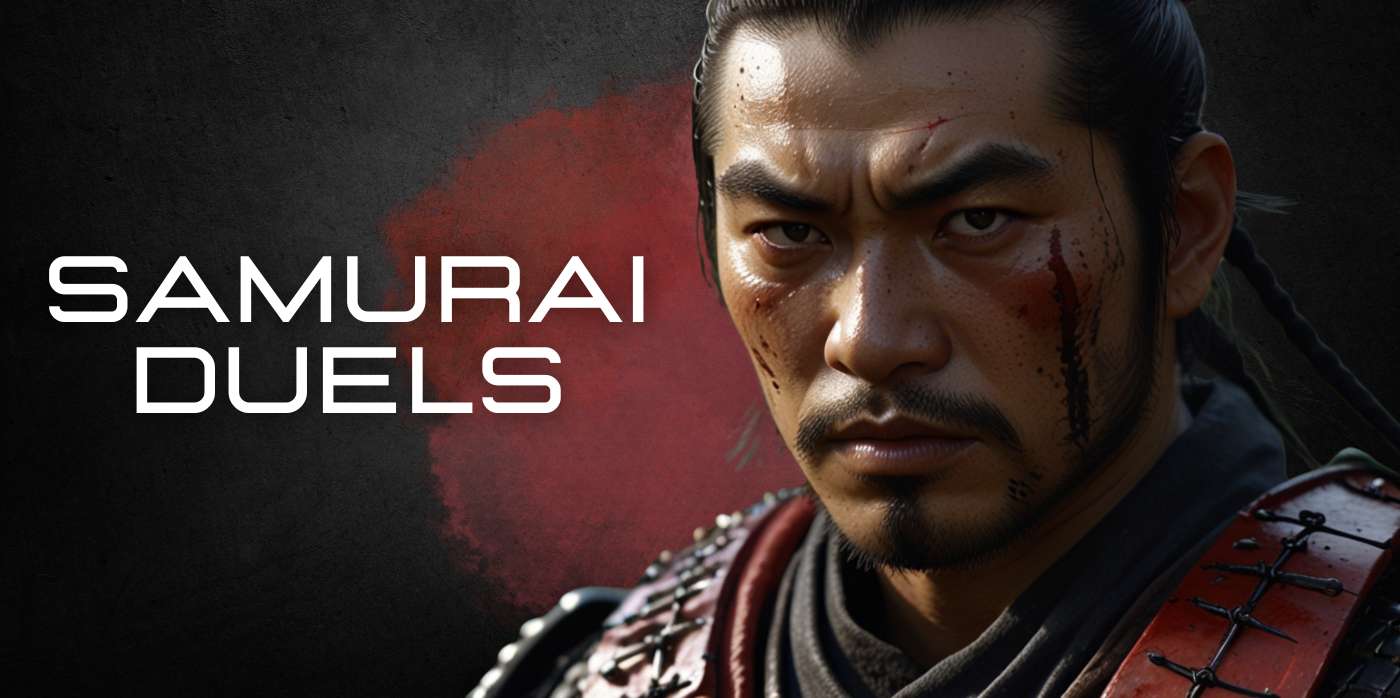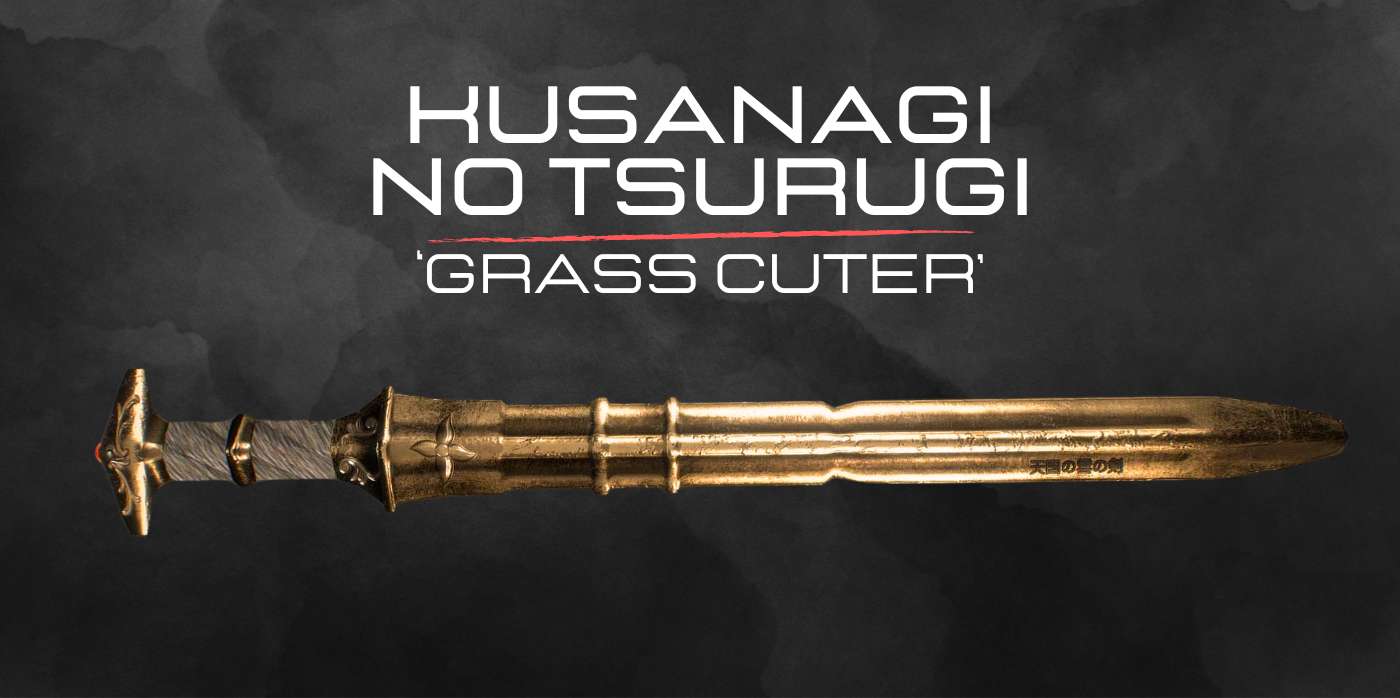Imagine a battlefield filled with the clash of swords, the thunder of hooves, and the gleam of meticulously crafted armor reflecting the sunlight. This was the world of the samurai, the legendary warriors of feudal Japan. Central to their identity was their armor, a blend of artistry, functionality, and profound symbolism.
The Origins of Samurai Armor
The origins of samurai armor can be traced back to ancient Japan, with influences from both domestic developments and interactions with neighboring cultures. The evolution of this iconic armor is a story of innovation, adaptation, and cultural synthesis.
Early Influences
The earliest forms of Japanese armor date back to the Yayoi period (300 BCE to 300 CE), characterized by rudimentary protective gear made from materials like leather and iron. During this time, Japan saw significant cultural exchanges with China and Korea, which influenced the development of Japanese armory. Early Japanese warriors, often members of the ruling elite, wore simple armor designed primarily for horseback combat.
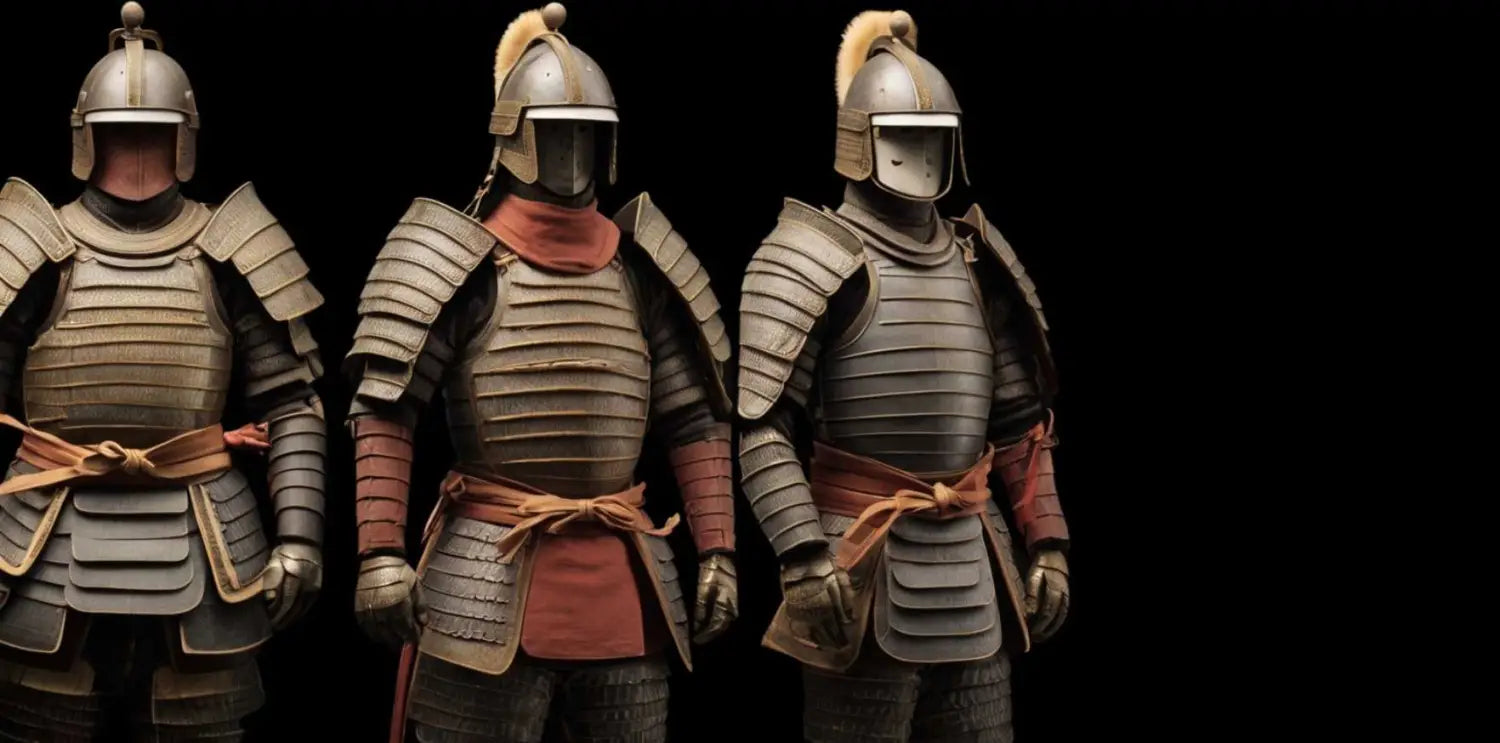
Japanese Armor Yayoi Period
Asuka and Nara Periods
By the Asuka (538-710 CE) and Nara (710-794 CE) periods, the influence of Chinese military practices became more pronounced. Japanese armorers began to incorporate Chinese techniques and designs, leading to the creation of lamellar armor. This type of armor consisted of small, overlapping metal or leather plates laced together, offering greater flexibility and protection compared to earlier designs.
Heian Period
The Heian period (794-1185 CE) marked a significant turning point in the evolution of samurai armor. During this time, the rise of the samurai class as a dominant military force in Japan led to the development of the ō-yoroi (great armor). The ō-yoroi was specifically designed for mounted archers, the primary role of samurai warriors during this period. This armor featured large, boxy shoulder guards and extensive protection for the chest and back, allowing samurai to remain agile while on horseback.
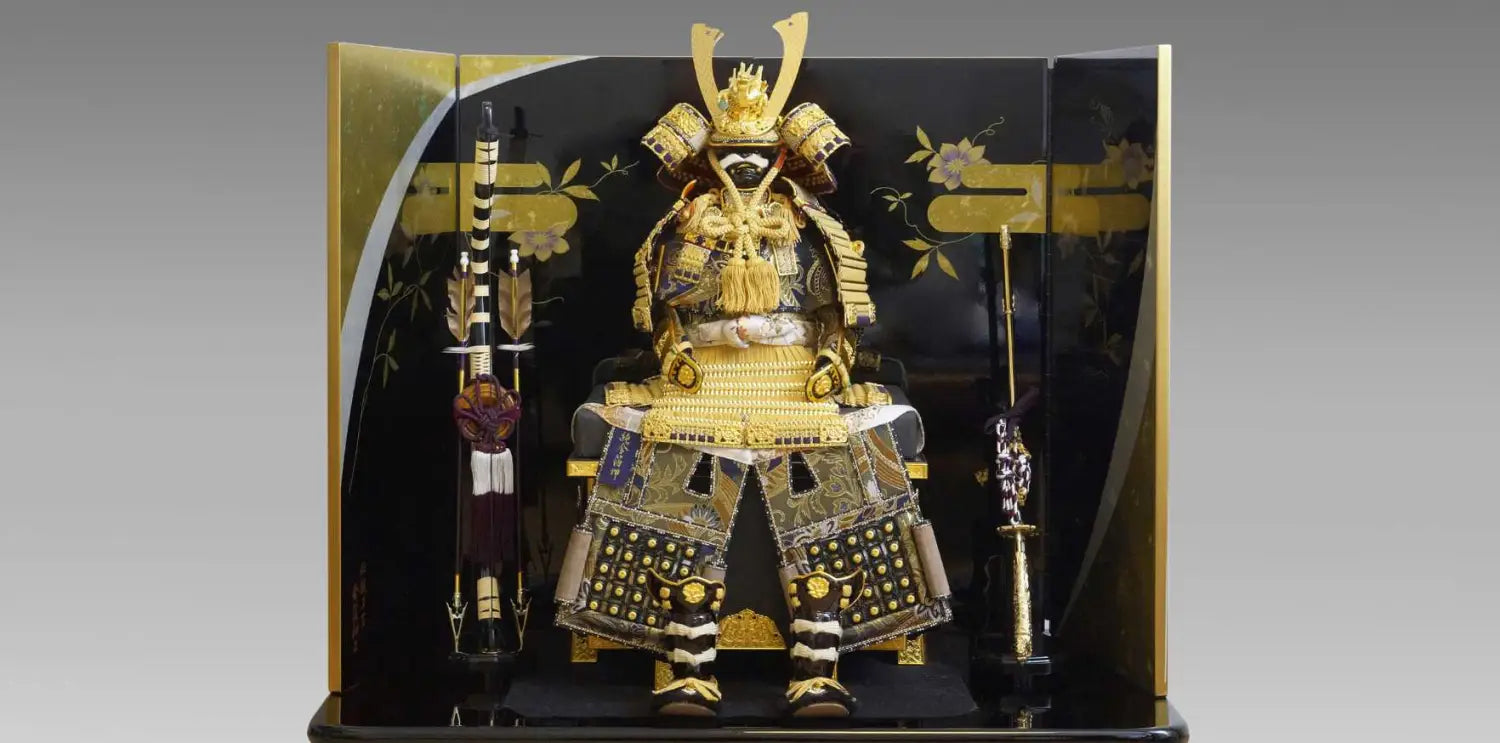
ō-yoroi armor, Heian period
Kamakura Period
The Kamakura period (1185-1333 CE) saw further advancements in armor design, driven by the need for better protection in increasingly brutal and frequent battles. The dō-maru (body wrap) and haramaki (belly wrap) styles emerged during this era. These armors were more form-fitting and provided greater mobility for infantry combat, reflecting the shift in samurai tactics from predominantly mounted warfare to more diverse battlefield roles.

do-māru armor, Kamukara period, Photo by Tokyo National Museum
Muromachi Period
In the Muromachi period (1336-1573 CE), Japan experienced continuous internal conflicts, known as the Sengoku period or Warring States period. This era of incessant warfare prompted rapid innovation in armor design. The tosei-gusoku (modern armor) became the standard, incorporating features like bulletproof iron plates and improved lacing techniques for enhanced durability and flexibility. The tosei-gusoku was highly customizable, allowing samurai to adapt their armor to specific battlefield needs.

Tosei-gusoku armor, Muromachi period
Influence of Western Contact
The arrival of Portuguese traders and missionaries in the 16th century introduced firearms to Japan, leading to significant changes in samurai armor. Armorers began to develop nanban-gusoku (foreign armor), which integrated elements of European armor, such as thicker iron plates to withstand bullets. This hybrid armor exemplified the adaptability of Japanese armorers in response to new technological challenges.
For those of you in a hurry, we recommend this video, which perfectly sums up the evolution of samurai armor.
Main Components of Samurai Armor

1. Kabuto (Helmet) 兜
The kabuto is perhaps the most iconic piece of samurai armor. Crafted from riveted iron plates, it was designed not only for protection but also to convey the wearer’s status and personality. The intricate designs often included elaborate crests and ornaments symbolizing power and authority. The kabuto was typically constructed with a large, bowl-like structure to shield the head, and it often featured a maedate (前立て), a decorative crest that served as a clan symbol or personal emblem. Additionally, the shikoro (しころ), a series of layered neck guards, provided extended protection for the neck and shoulders, enhancing both safety and the armor's aesthetic appeal.
2. Menpo (Face Mask) 面頬
Menpo (or men-yoroi), the face mask, served dual purposes: protection and intimidation. These masks, often crafted from iron and leather, came in various forms, from full face masks to half masks. They were designed to deflect arrows and swords while also presenting a fearsome visage to the enemy. Menpo often featured intricate designs, including fierce expressions and details such as mustaches and teeth, which were intended to intimidate opponents and evoke fear. Some menpo were designed with detachable nose pieces, allowing for better ventilation and comfort during long battles.
3. Dō (Chest Armor) 胴
The dō protected the torso and was made from iron or leather scales lacquered to prevent rust. This piece evolved from simpler designs to highly articulated constructions that allowed greater flexibility and movement, reflecting the changing needs of samurai warriors over centuries. The dō typically featured a combination of small, overlapping plates known as kozane (小札) or larger, more articulated plates known as ita-mono (板物), which provided a balance between mobility and protection. The dō was often secured with intricate silk lacing (odoshi, 威し), which added both structural integrity and visual appeal.
4. Kote (Armored Sleeves) 篭手
Kote were sleeves that extended from the shoulder to the back of the hand, often incorporating chainmail and iron plates. These were crucial in protecting the arms during combat while maintaining enough flexibility for wielding weapons effectively. Kote typically included a combination of kusari (鎖, chainmail) and kawa (革, leather) sections, allowing for a mix of protection and mobility. The sleeves were often padded with layers of fabric to absorb impacts and prevent chafing, ensuring that the samurai could maintain their dexterity and grip on their weapons.
5. Fauld (Kusazuri) 草摺
Kusazuri are hanging plates attached to the lower edge of the dō. They protect the hips and upper legs, extending the protection provided by the main cuirass. Kusazuri are typically made from small iron or leather plates sewn onto a fabric backing, allowing for flexibility and movement while safeguarding the lower body.
6. Haidate (Thigh Guards) 臑当て
Haidate covered the thighs and were typically made from small iron plates sewn onto a cloth backing. This piece of armor was essential for protecting the legs while allowing enough movement to fight effectively on foot or horseback. Haidate were usually attached to the waist and secured around the thighs with ties or buckles, ensuring they stayed in place during movement. The iron plates, often arranged in rows or sections, provided a balance between protection and flexibility, allowing the samurai to move freely while guarding against cuts and thrusts to the upper legs.
7. Suneate (Shin Guards) 脛当て
Suneate protected the shins and were vital for mobility and defense. Early versions were simple iron splints, but they evolved into complex constructions with articulated plates, providing both protection and agility. The suneate typically consisted of vertical iron splints or plates attached to a fabric or leather backing, secured with straps or lacing. This design allowed for flexibility while walking or running, crucial for maintaining speed and maneuverability in battle. Some suneate also included additional padding or chainmail for enhanced protection against direct strikes.
Auxiliary Armors in Samurai Warfare
In addition to the primary components of samurai armor, several types of auxiliary armors were developed to provide extra protection and flexibility in combat. These auxiliary armors complemented the main suit of armor, enhancing the overall defense and adaptability of the samurai on the battlefield.
Nodowa (Throat Guard) 喉輪
Nodowa is a throat guard designed to protect the neck area, which is particularly vulnerable during combat. Typically made from small iron plates or chainmail, nodowa was worn around the neck and secured to the helmet or chest armor. It provided essential defense against slashes and thrusts to the throat, a critical area in combat.
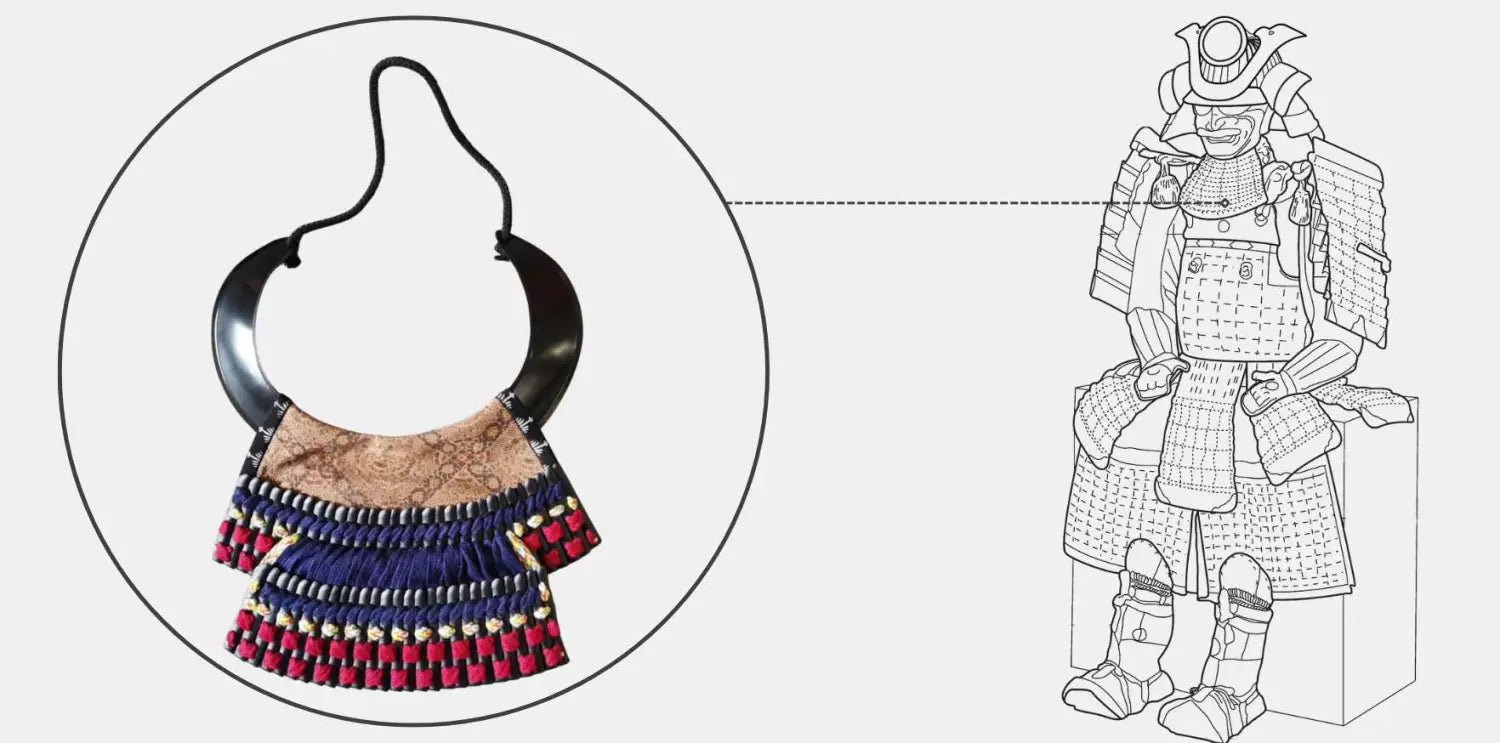
Tatami-gusoku (Folding Armor) 畳具足
Tatami-gusoku refers to lightweight, portable armor designed for ease of transport and rapid deployment. It typically consisted of small, interlocking plates or chainmail sewn onto a fabric backing. Tatami-gusoku was highly flexible, allowing for a wide range of movement. It could be easily folded or rolled, making it convenient for travel. Although lighter and less protective than full armor, tatami-gusoku provided adequate defense for scouts, messengers, and warriors needing mobility.
Manchira (Padded Armor) 胸当て
Manchira is a type of padded armor worn beneath the main suit of armor. It was usually made from layers of fabric, cotton padding, and sometimes included small metal plates or chainmail. The padding of the manchira helped cushion the body against the weight and pressure of the main armor, reducing chafing and increasing comfort. The added layers provided extra insulation and could help absorb some of the impact from blows.
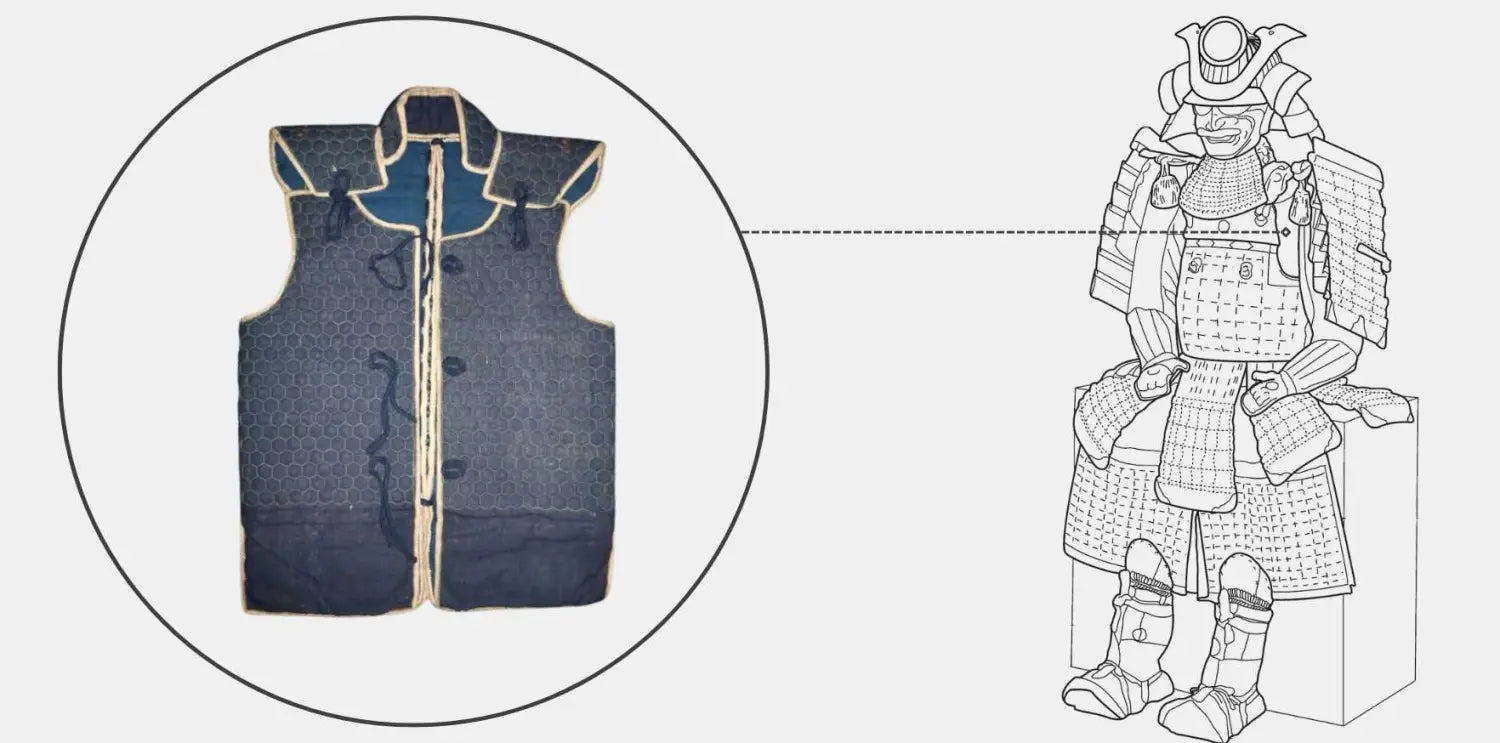
Kusazuri (Tassets) 草摺
Kusazuri were hanging plates attached to the dō (chest armor) to protect the hips and upper legs. They extended protection to the sides and front of the lower torso, complementing the haidate and suneate. Designed to allow movement while safeguarding the lower body.
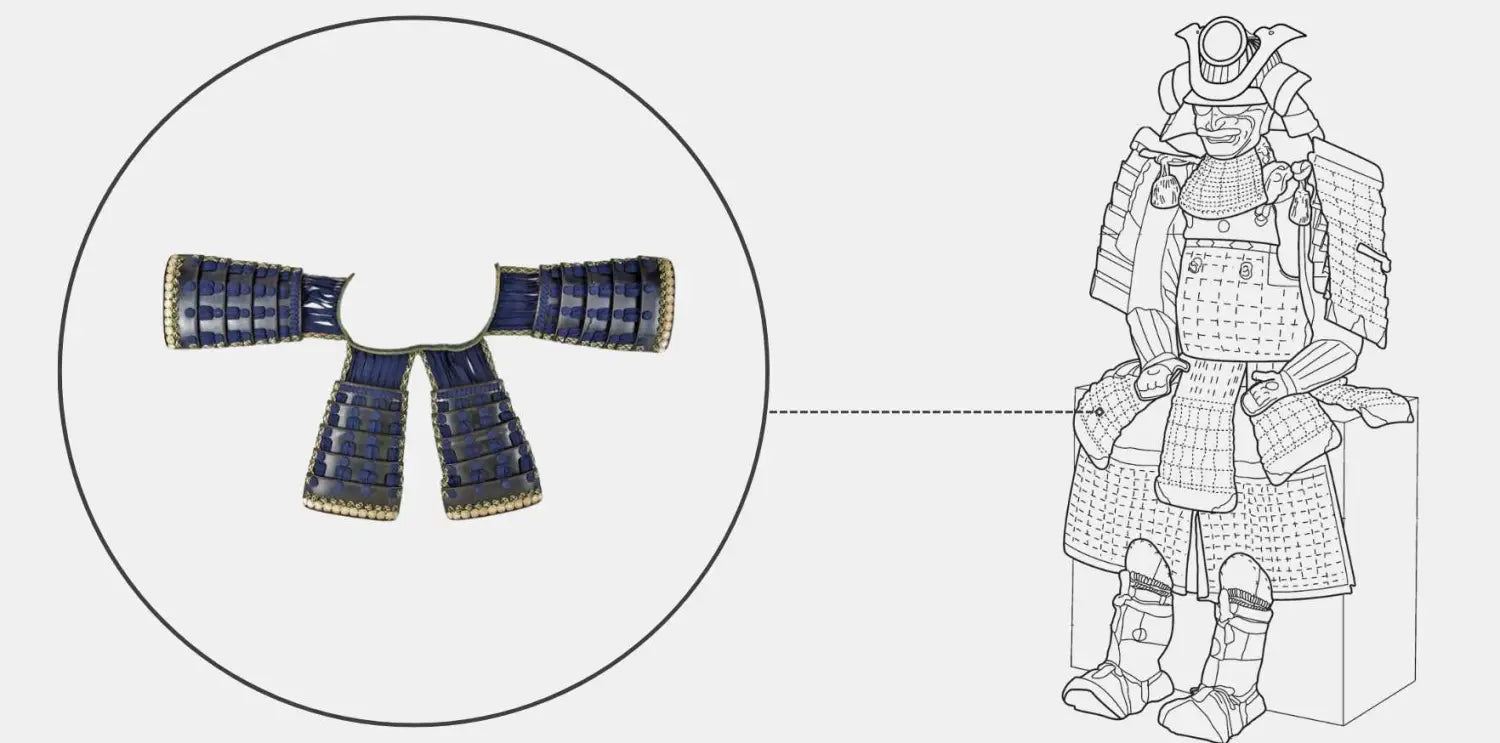
Kusari (Chainmail) 鎖
Kusari is a type of chainmail armor that was used to cover areas of the body not protected by solid plates. Made from small, interlinked iron rings, kusari provided flexibility and additional protection against cuts and thrusts. Kusari was often integrated into other armor pieces such as kote (armored sleeves), haidate (thigh guards), and suneate (shin guards). It was also worn as a separate garment beneath or between layers of armor. While not as impenetrable as solid plates, kusari was effective against slashing attacks and added a layer of defense to vulnerable areas.
Kogake (Armored Socks) 甲掛
Kogake were armored socks designed to protect the feet and lower legs. They often included small metal plates or chainmail integrated into the fabric. Kogake shielded the feet from sharp objects on the ground and potential strikes during close combat. They allowed for greater flexibility and movement compared to heavier foot armor.
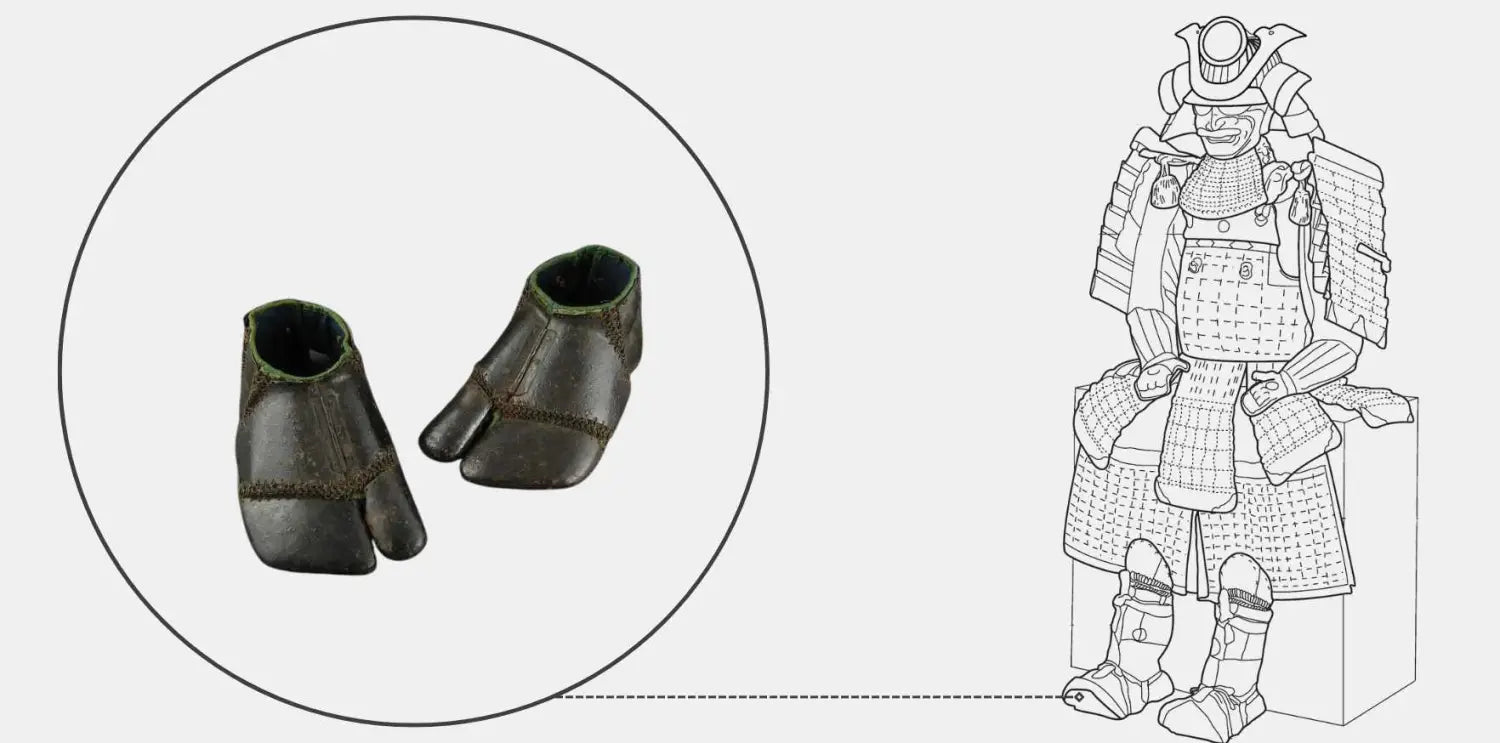
Clothing Worn with Samurai Armor
Samurai armor was not worn in isolation but was accompanied by various garments that provided additional protection, comfort, and functionality. These garments played a crucial role in ensuring the overall effectiveness and mobility of the samurai warrior.
Undergarments
Fundoshi: This was a traditional Japanese undergarment, a type of loincloth that was commonly worn by men. The fundoshi was essential for maintaining hygiene and comfort beneath the heavy layers of armor.
Hakama: Hakama were wide-legged trousers that samurai wore over their fundoshi. Made from durable fabric, hakama provided ease of movement and additional protection. They were often secured with a belt, known as an obi, around the waist.
Base Layers
Kimono: Beneath the armor, samurai typically wore a kimono, a traditional Japanese robe. The kimono was made from silk or cotton, depending on the weather and the samurai's status. It acted as a base layer, absorbing sweat and preventing the armor from chafing against the skin.
Hitoe: This was an unlined kimono, usually worn in warmer weather. The hitoe was lightweight and allowed for better ventilation, helping to keep the samurai cool under the layers of armor.
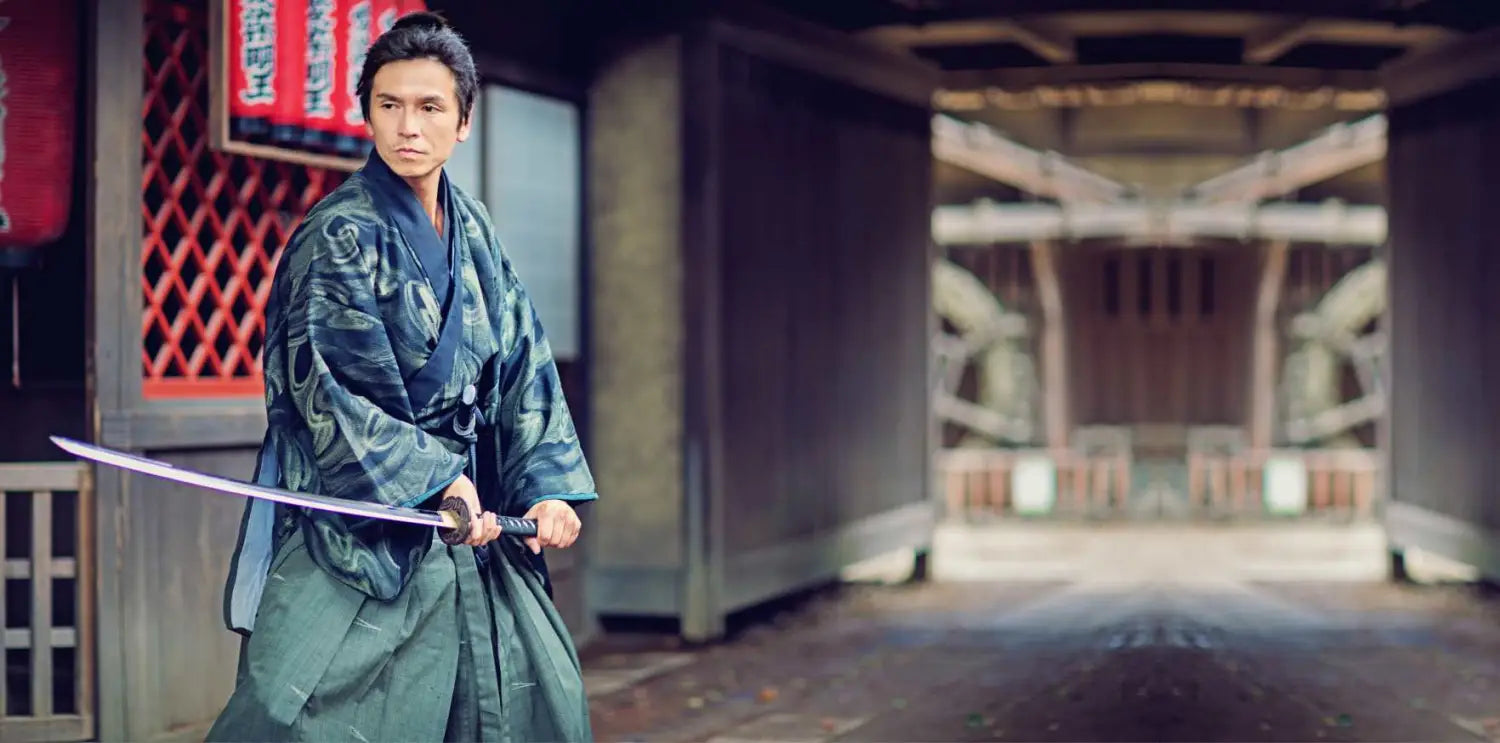
Samurai wearing a kimono
Protective Garments
Uwa-obi: A wide belt or sash that was tied around the waist to secure the armor and hold the samurai sword in place. The uwa-obi was often decorated and symbolized the samurai's rank and clan affiliation.
Tatami-gusoku: These were folding armors worn over the kimono for additional protection. Made from small, interlocking plates, tatami-gusoku provided flexibility and were often used for lightweight or travel armors.
Outer Garments
Jimbaori: An overcoat worn over the armor, typically during ceremonial occasions or in cold weather. The jimbaori was often elaborately decorated with the samurai’s family crest (kamon) and other symbols, showcasing their status and affiliation.
Sode: Large, rectangular shoulder guards that were tied to the dō (chest armor) with cords. Sode provided protection for the upper arms and shoulders while allowing for movement.
Tebukuro: Traditional gloves that protected the hands. Made from sturdy fabric or leather, tebukuro were often padded to prevent blisters and provide a better grip on weapons.
Footwear
Tabi: Split-toe socks worn with traditional Japanese footwear. Tabi were made from sturdy fabric and provided comfort and protection, especially when wearing sandals or other types of footwear.
Waraji: Straw sandals that were commonly worn by samurai when not in battle. Waraji were lightweight and practical, suitable for long marches and everyday activities.
Kegutsu: Wooden clogs or platform shoes worn in wet or muddy conditions. Kegutsu elevated the feet above the ground, preventing the armor and garments from getting dirty or wet.
Headgear
Kasa: A conical hat made from straw or bamboo, worn during travel or when not in battle. The kasa, or samurai straw hat, provided protection from the sun and rain.
Hachimaki: A headband worn beneath the kabuto (helmet). The hachimaki absorbed sweat and helped to secure the helmet in place, preventing it from shifting during combat.
Materials and Craftsmanship in Samurai Armor
The materials and craftsmanship involved in creating samurai armor were critical to its effectiveness, durability, and aesthetic appeal. Master armorers, known as katchu-shi, dedicated their lives to perfecting the art of armor-making, ensuring that each piece was both functional and a work of art.
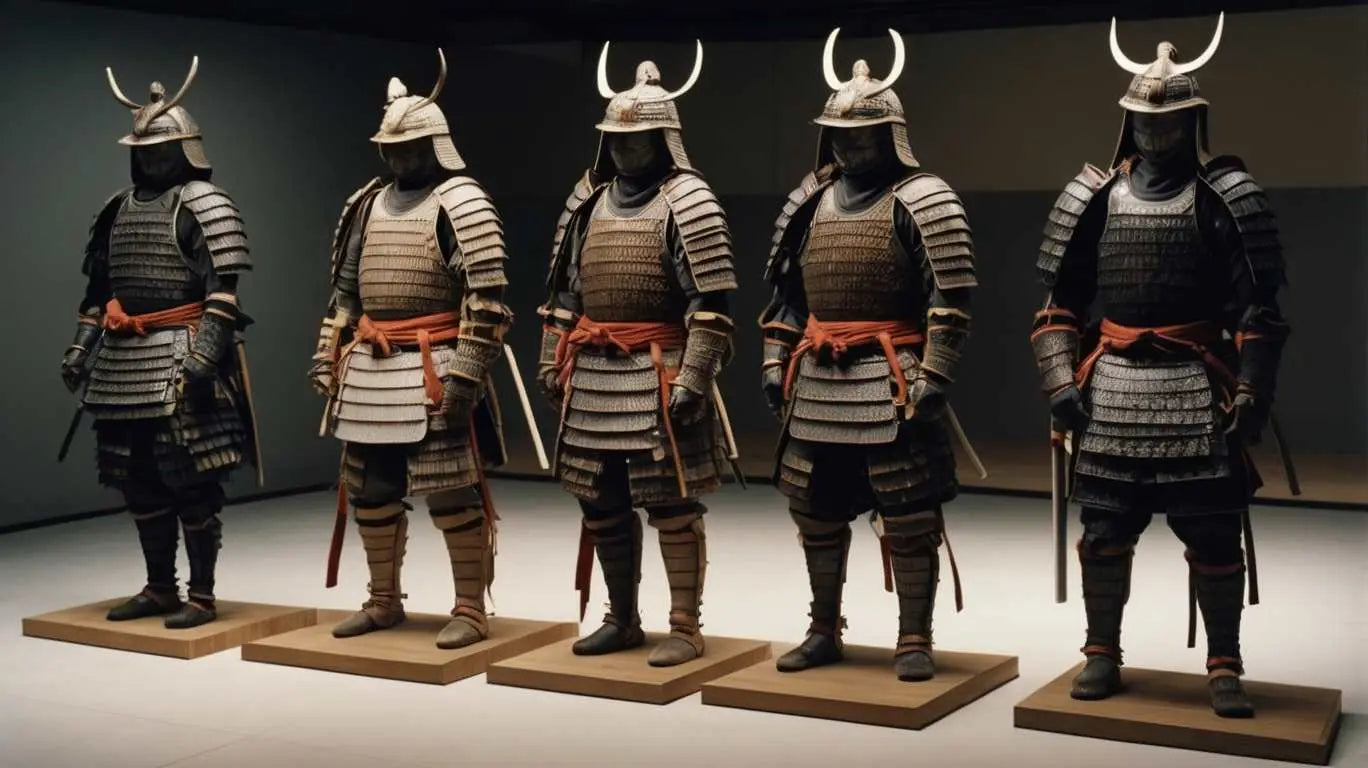
Traditional Materials Used
The primary materials used in samurai armor included iron, leather, silk, and lacquer. Each material played a specific role in the construction and performance of the armor:
- Iron: Iron was the primary material for the plates and scales that made up the protective elements of the armor. It was chosen for its strength and ability to be shaped and tempered.
- Leather: Leather was used for various components, including some armor plates, straps, and bindings. It was often hardened through processes such as boiling to increase its protective capabilities.
- Silk: Silk was used for the intricate lacing (odoshi) that held the armor plates together. It was strong, durable, and could be dyed in various colors for decorative purposes.
- Lacquer: Lacquer was applied to iron and leather components to protect them from rust and wear. It also provided a glossy finish that could be further decorated with intricate designs.
Techniques of Armor-Making
The craftsmanship of samurai armor was a meticulous process that required a high degree of skill and knowledge. Some of the key techniques included:
- Plate Making: Iron plates were forged and shaped through hammering and heating. These plates were often curved to fit the body’s contours and provide maximum protection with minimal weight.
- Lamellar Construction: Small, overlapping plates or scales were laced together with silk or leather cords to create flexible yet protective sections. This technique allowed for movement while maintaining defense.
- Lacquering: The application of lacquer involved multiple layers, each carefully dried and polished. This process not only protected the metal and leather but also added to the armor's visual appeal.
- Odoshi (Lacing): The lacing of armor plates was a complex process that required precision. The lacing patterns varied depending on the region, period, and status of the wearer, and they added both strength and beauty to the armor.
- Embossing and Engraving: Decorative techniques such as embossing and engraving were used to add intricate designs and motifs to the armor. These could include family crests, mythological creatures, and spiritual symbols.

Samurai armor engraved with motifs
Preservation and Restoration of Samurai Armor
Preserving and restoring samurai armor is a meticulous process that involves advanced techniques and a deep understanding of historical craftsmanship. This ensures to safeguard the historical value, cultural significance, and educational resources that samurai armor provides.
Challenges in preservation include material degradation, complex construction, and environmental factors. Over time, iron can rust, leather can dry out and crack, and silk can deteriorate. The intricate construction of samurai armor, with its numerous small plates and lacing, makes it difficult to restore without causing damage. Additionally, temperature, humidity, and light exposure can negatively affect the condition of the armor, necessitating optimal storage conditions.
Techniques in restoration combine traditional methods with modern technology to repair and maintain the integrity of the pieces. Gentle cleaning is performed to remove dust, dirt, and corrosion, using soft brushes, air blowers, and specialized cleaning agents that do not harm the materials. To prevent further degradation, conservators stabilize the materials by applying rust inhibitors to iron and using leather conditioners to prevent cracking.
Repairing the lacing (odoshi), which holds the armor plates together, often requires replacement. Conservators use traditional techniques to re-lace the armor, sometimes even recreating the original dyeing process to match the historical appearance. Metal restoration involves reshaping bent plates, filling in missing sections with compatible materials, and applying protective coatings to prevent future rust. Leather treatment includes using oils and conditioners to restore flexibility and prevent further drying and cracking.
Modern restoration tools have significantly improved the ability to restore and preserve samurai armor. High-powered microscopes allow conservators to examine the armor in detail, identifying areas of damage that may not be visible to the naked eye. 3D scanning and printing technologies are used to create precise replicas of missing components, ensuring that replacements fit perfectly without altering the original structure. Environmental monitoring systems regulate temperature, humidity, and light exposure in storage and display areas, creating optimal preservation conditions.
Several case studies in restoration highlight the meticulous work involved. The Tokyo National Museum employs state-of-the-art conservation techniques to maintain its extensive collection of samurai armor, often including public displays to educate visitors. The Metropolitan Museum of Art uses both traditional Japanese methods and modern technology to preserve its collection, and many private collectors invest in the restoration and preservation of samurai armor, working with expert conservators to ensure authenticity and integrity.
Educational and public engagement are also crucial components of restoration projects. Museums and cultural institutions frequently hold workshops and demonstrations where conservators explain and showcase restoration techniques. Special exhibitions dedicated to samurai armor often include information on the preservation process, highlighting the intricate work involved. Detailed publications and research papers provide insights into the restoration techniques and the historical context of the armor.
FAQ about Samurai Armour
How Heavy is Samurai Armor?
Samurai armor, known as yoroi, typically weighed between 20 to 45 pounds (9 to 20 kilograms). This range depended on several factors, including the period in which the armor was made, the materials used, and the specific type of armor.
Generally, traditional samurai armor was designed to balance protection and mobility, so it was relatively lightweight compared to the full plate armor worn by European knights.
Is Samurai Armor Bulletproof?
Samurai armor was primarily designed to protect against arrows, swords, and other melee weapons but not bullets. With the introduction of firearms to Japan in the 16th century, armorers had to adapt their designs to provide some level of protection against bullets.




